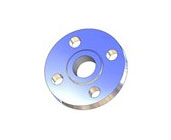Flanges
A Flange allows two pipes to be mechanically connected together, or a pipe to be mechanically connected to a valve, tee, choke or other piece of equipment. The principle of a flange is to use a mechanical force (exerted by the bolts) to pre - load the gasket sufficiently so that when internal pressure (end cap force) is applied, there is enough contact stress between the flanges and gasket to maintain a seal.
The Flange it self needs to be connected to the pipe. This is usually achieved by welding though threaded and other weldless connections also exist.
Weldneck
These are the most common type of flanges used for high-pressure application.It is designed to transfer stresses concentrations of the base of the flanges. These are recognized by their long tapered hub. The hub provides an important reinforcement to the flange itself and acts to reduce rotation of the flange at bolt up. The smooth transition between flange and the hub combinbed with the strength of the butt weld joint, allows the flanges to be used in extreme conditions of cyclic loading, bendng and temperature fluctuations.

Slip On
The slip-on flange has a low hub because the pipe slips into the flange prior to welding. It is welded both inside and out to provide sufficient strength and prevent leakage. They are ideal for low pressure applications.

Socket Weld
These flanges have a bore and counter bore dimension. The counter bore is slightly larger than the O.D of the matching pipes, allowing pipes, allowing the pipe to be inserted into the flanges. The diameter of the smaller bore is the same as the I.D of the matching pipe. During assembly, the pipe is inserted in the larger diameter bore andis welded in place. This type of flange is often used with high-pressure systems that use smaller diameter pipes. These flanges application is in Chemicals, Hydraulics and Steams plants.

Threaded
The threaded flange is similar to slip-on flanges, but the difference is that the bore is threaded.It can be fitted to the pipe without welding. It is use in low-pressure services at ambient temperatures, and in highly explosive areas where welding creates a hazard.

Lap Joint
The lap joint flange is practically identical to a slip-on flange except it has a larger radius at the intesections of the bore and flange face. It is used with their associated stub end. The stub end is welded to the pipe and the lap joint then works as a backjing ring. The advantage of this flange is that the bolt holes can be aligned with the matching flange after the weld have been completed. This flange is not suitable for areas with thigh external or dynamic loads.

Blind
The Blind flange is a flange without an opening or bore. It is used to close off the ends of a piping systems and/or a pressure vessel opening. They may often be supplied with NPT fittings to allow pressure test connections to be fitted.

Long Weldneck
These flanges are used primarily as outlets on pressure vessels and tanks. The bore is always the nominal size of the flanges, regardless of the nominal size of the flanges, regardless of the pressure rating, and the standard length is 9 inch or 12 inch.

Orifice
These are used in pairs and meter the flow of liquids and gases through a pipe by clamping an Orifice plate between two flanges. All sizes of orifice flanges are available as WeldNeck, Slip-On and Threaded in 300 pounds pressure and higher.

Reducing Flange
A Reducing flange consists of a flange with one specified diameter having a bore of a different and smaller, diameter. Except for the bore and hub dimensions, the flange will have dimensions of the larger pipe size.

Custom Flange
We also make custom flanges as per the drawing


Products
Quality
We at ML Star Engineering products are committed to satisfy our customer requirements,by supplying Quality products on time,Every time by adopting process management on a continual endeavour.
